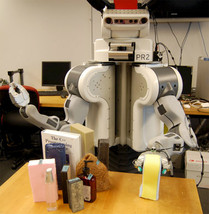/ News

Finally: Robots Learn What 'Squishy' Really Means
Humans use all sorts of bizarre, abstract terms to describe how objects feel, and it’s endlessly frustrating to robots. Or at least, we imagine it must be. Take a word like "squishy," for example: how would you explain that feeling to a robot who experiences touch through some long series of numbers? Researchers at University of Pennsylvania's Haptics Group (part of theGRASP Lab) and UC Berkeley have developed a system to teach robots how these abstract terms apply to real-world objects, to help our mechanical friends communicate with us in a more relatable way.
In robotics, the science of touch and touch interaction is called haptics, and at the IEEE International Conference on Robotics and Automation (ICRA) this year, haptics has been all over the place. It’s a tricky thing to experiment with, because it requires sophisticated sensors, and equally sophisticated software to understand what the sensors are saying. Translating such sensor data into something that a human can understand is especially difficult, but in a paper presented this week, a PR2 robot equipped with an innovative finger sensor from SynTouch has been taught to use touch exploration to associate objects with "tactile adjectives."
A tactile adjective is a word like "squishy." "Fuzzy" is another one, and so is "crinkly." Humans easily understand what those terms mean. But robots still have a lot to learn. The study had a bunch of humans feel up a set of common household items, resulting in 34 adjective labels:

The researchers then had a PR2 with the BioTac tactile finger sensor perform a series of exploratory procedures on the same set of objects, including tapping, squeezing, holding, and both slow and fast sliding. Here’s a video of PR2 exploring a folded satin pillowcase through touch:
After training the PR2 by correlating haptic sensor data with adjectives from humans who touched the same objects, the robot was tested out on a series of objects that it had never experienced before to see whether it would be able to derive the same haptic adjectives as humans do. And it worked. As shown in the video above (although it flashes past pretty quickly at the end), humans described the folded satin pillowcase as "compact, compressible, deformable, smooth, and squishy," while the robot thought it was "compact, compressible, crinkly, smooth, and squishy." I’m not sure where "crinkly" came from, but the rest of it is pretty close, and it’s very impressive for words that have a tendency towards subjectiveness. The researchers summarize:
The presented results prove that a robot equipped with rich multi-channel tactile sensors can discover the haptic properties of objects through physical interaction and then generalize this understanding across previously unfelt objects. Furthermore, we have shown that these object properties can be related to subjective human labels in the form of haptic adjectives, a task that has rarely been explored in the literature, though it stands to benefit a wide range of future applications in robotics.
"Using Robotic Exploratory Procedures to Learn the Meaning of Haptic Adjectives," by Vivian Chu, Ian McMahon, Lorenzo Riano, Craig G. McDonald, Qin He, Jorge Martinez Perez-Tejada, Michael Arrigo, Naomi Fitter, John C. Nappo, Trevor Darrell, and Katherine J. Kuchenbecker from the University of Pennsylvania and the University of California, Berkeley, was presented last week at ICRA 2013 in Germany.
Source: http://spectrum.ieee.org/automaton/robotics/robotics-hardware/finally-robots-learn-what-squishy-really-means
/ About us
Founded by Russian entrepreneur Dmitry Itskov in February 2011 with the participation of leading Russian specialists in the field of neural interfaces, robotics, artificial organs and systems.
The main goals of the 2045 Initiative: the creation and realization of a new strategy for the development of humanity which meets global civilization challenges; the creation of optimale conditions promoting the spiritual enlightenment of humanity; and the realization of a new futuristic reality based on 5 principles: high spirituality, high culture, high ethics, high science and high technologies.
The main science mega-project of the 2045 Initiative aims to create technologies enabling the transfer of a individual’s personality to a more advanced non-biological carrier, and extending life, including to the point of immortality. We devote particular attention to enabling the fullest possible dialogue between the world’s major spiritual traditions, science and society.
A large-scale transformation of humanity, comparable to some of the major spiritual and sci-tech revolutions in history, will require a new strategy. We believe this to be necessary to overcome existing crises, which threaten our planetary habitat and the continued existence of humanity as a species. With the 2045 Initiative, we hope to realize a new strategy for humanity's development, and in so doing, create a more productive, fulfilling, and satisfying future.
The "2045" team is working towards creating an international research center where leading scientists will be engaged in research and development in the fields of anthropomorphic robotics, living systems modeling and brain and consciousness modeling with the goal of transferring one’s individual consciousness to an artificial carrier and achieving cybernetic immortality.
An annual congress "The Global Future 2045" is organized by the Initiative to give platform for discussing mankind's evolutionary strategy based on technologies of cybernetic immortality as well as the possible impact of such technologies on global society, politics and economies of the future.
Future prospects of "2045" Initiative for society
2015-2020
The emergence and widespread use of affordable android "avatars" controlled by a "brain-computer" interface. Coupled with related technologies “avatars’ will give people a number of new features: ability to work in dangerous environments, perform rescue operations, travel in extreme situations etc.
Avatar components will be used in medicine for the rehabilitation of fully or partially disabled patients giving them prosthetic limbs or recover lost senses.
2020-2025
Creation of an autonomous life-support system for the human brain linked to a robot, ‘avatar’, will save people whose body is completely worn out or irreversibly damaged. Any patient with an intact brain will be able to return to a fully functioning bodily life. Such technologies will greatly enlarge the possibility of hybrid bio-electronic devices, thus creating a new IT revolution and will make all kinds of superimpositions of electronic and biological systems possible.
2030-2035
Creation of a computer model of the brain and human consciousness with the subsequent development of means to transfer individual consciousness onto an artificial carrier. This development will profoundly change the world, it will not only give everyone the possibility of cybernetic immortality but will also create a friendly artificial intelligence, expand human capabilities and provide opportunities for ordinary people to restore or modify their own brain multiple times. The final result at this stage can be a real revolution in the understanding of human nature that will completely change the human and technical prospects for humanity.
2045
This is the time when substance-independent minds will receive new bodies with capacities far exceeding those of ordinary humans. A new era for humanity will arrive! Changes will occur in all spheres of human activity – energy generation, transportation, politics, medicine, psychology, sciences, and so on.
Today it is hard to imagine a future when bodies consisting of nanorobots will become affordable and capable of taking any form. It is also hard to imagine body holograms featuring controlled matter. One thing is clear however: humanity, for the first time in its history, will make a fully managed evolutionary transition and eventually become a new species. Moreover, prerequisites for a large-scale expansion into outer space will be created as well.
Key elements of the project in the future
• International social movement
• social network immortal.me
• charitable foundation "Global Future 2045" (Foundation 2045)
• scientific research centre "Immortality"
• business incubator
• University of "Immortality"
• annual award for contribution to the realization of the project of "Immortality”.



 LinkedIn
LinkedIn
 LiveJournal
LiveJournal
 Google
Google
 Twitter
Twitter
 Facebook
Facebook
 Я.ру
Я.ру
 ВКонтакте
ВКонтакте
 Mail.ru
Mail.ru